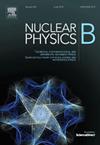A new-old approach to composite scalars with chiral fermion constituents
IF 2.5
3区 物理与天体物理
Q2 PHYSICS, PARTICLES & FIELDS
引用次数: 0
Abstract
We develop a dynamical, Lorentz invariant theory of composite scalars in configuration space consisting of chiral fermions, interacting by the perturbative exchange of a massive “gluon” of coupling and mass (the coloron model). The formalism is inspired by, but goes beyond, old ideas of Yukawa and the Nambu-Jona-Lasinio (NJL) model. It yields a non-pointlike internal wave-function of the bound state, , which satisfies a Schrödinger-Klein-Gordon (SKG) equation with eigenvalue . For super-critical coupling, , we have leading to spontaneous symmetry breaking. The binding of chiral fermions is semiclassical, not loop-level as in NJL. The mass scale is determined by the interaction as in NJL. We mainly focus on the short-distance, large limit, yielding an NJL pointlike interaction, but the bound state internal wave-function, , remains spatially extended and dilutes . This leads to power-law suppression of the induced Yukawa and quartic couplings and requires radically less fine-tuning of a hierarchy than does the NJL model. We include a discussion of loop corrections of the theory. A realistic top condensation model appears possible.
求助全文
约1分钟内获得全文
求助全文
来源期刊

Nuclear Physics B
物理-物理:粒子与场物理
CiteScore
5.50
自引率
7.10%
发文量
302
审稿时长
1 months
期刊介绍:
Nuclear Physics B focuses on the domain of high energy physics, quantum field theory, statistical systems, and mathematical physics, and includes four main sections: high energy physics - phenomenology, high energy physics - theory, high energy physics - experiment, and quantum field theory, statistical systems, and mathematical physics. The emphasis is on original research papers (Frontiers Articles or Full Length Articles), but Review Articles are also welcome.
 求助内容:
求助内容: 应助结果提醒方式:
应助结果提醒方式:


